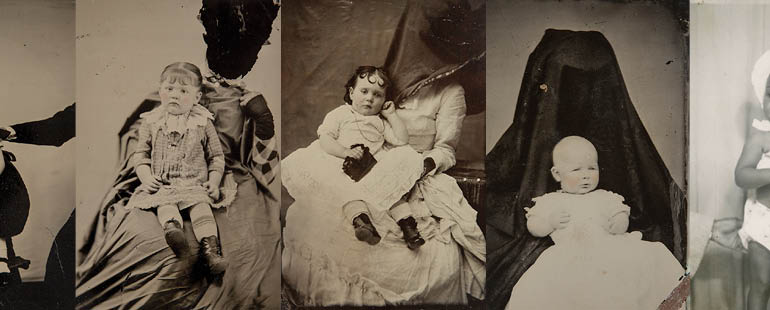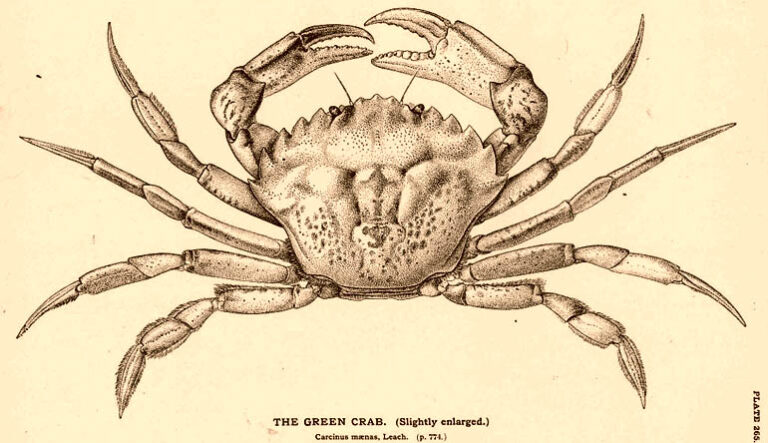Hidden Mother’s Maternal Haunted House

At first glance, you might not even notice that the baby is sitting on a lap. Instead, you might think she’s propped delicately on a pile of soft linens. But if you look closer, you’ll see the hand. It is slid carefully underneath the hem of the child’s white dress, holding her in place so she does not move. This is the hand of the child’s mother, but the mother’s face is hidden by a large, black cloth draped over the top half of her body. By obscuring her, her child becomes the sole focus. Here, the mother is nothing more than a prop, scaffolding meant only to support her daughter and keep her still so that the long exposure of this nineteenth-century photograph has a chance at developing unblurry.
This photograph and others like it are the subject of photographer Laura Larson’s 2018 book, Hidden Mother. In it, Larson analyzes the images of women in nineteenth-century photos who hold babies still for pictures while remaining cleverly disguised from the eye of the camera themselves. Many of the women in these photos—many of these mothers—exist shrouded in fabric, their bodies strange forms in front of which their children sit. In instances where it is impossible to hide the mother’s face, she is scratched out after the fact, leaving behind a large, black mass where her head used to be. In one of my favorite pictures, a woman exists on the periphery doing her best to not lean into the frame too much as she steadily attempts to prop up her child on a stool. To Larson, these mothers have a “structural but visually peripheral role.” The goal here is not to document the maternal relationship between the two individuals—it is to take an acceptable portrait of the mother’s child.
When I first looked at these images, I felt a sense of unease. The unseen women in these photographs were unsettling to look at mostly because they are still visible, albeit shrouded. As the viewers, we are supposed to pretend they are not there even though it is glaringly obvious that they are. The reality of their presence during the taking of the photo can’t be helped, and to ignore this fact felt wrong—as if I would be ignoring the very essence of the mother’s being. Larson feels similarly about these women. She takes care to note how their obstruction gives way to the concept of mothering. She understands that by obscuring the mothers in these photos of their children, the images become symbols for the invisibility of all that a mother does for their child. “She’s an open secret, essential but obscured, in service to the greater good: the picture,” writes Larson. Of course, “the greater good” is not just the picture, but also the home in which the mother and child live.
Today, the ongoing dialogue about the nature of domestic work is fierce, especially since so much of it often falls unfairly on the shoulders of women. Mothers especially are constantly juggling a million different tasks just to keep their houses running smoothly. Children’s schedules need to be coordinated so that everyone can be dropped off and picked up from school on time. Laundry and dishes need to get done. Babies need baths and bedtime stories and someone to make and take them to their many doctor’s appointments. And then there are the dozens of other little things that must be remembered, things as miniscule as keeping track of when it’s time to buy more ketchup or what kind of juice boxes each child in the household prefers. Often, many mothers perform this work quietly. Their daily labors go unnoticed because the house never falls into disarray. Instead, the mothers and their work float quietly underneath the invisible shroud of domesticity, unrecognized by those around them even though the house could not function without them.
“These images remind me of dressing up as a ghost when I was a kid,” writes Larson, and she’s right. There is something supremely ghost-like about the photographs of these hidden mothers. It is a combination of the cloth draped over their bodies giving them the appearance of a child dressed up as a ghost on Halloween and the fact that their presence in the images is meant to be invisible even though they are so clearly there. When we think of ghosts, we think of hauntings, and what are these mothers doing if not haunting the images of their children? In every image they hang over their little ones like obvious specters, and much like a ghost has ties to their once corporeal selves, these mothers reach from the beyond to gently hold their children up. Ghosts cling to those to whom they had strong ties while they were alive, and what is stronger than the ties a mother has to their child?
To mother a child is to hover. Much like a ghost, you shadow the lives of your children while often giving up much of your own. Ghosts are often known to haunt domestic spaces, the same spaces in which mothers spend so much of their time. Both mothers and ghosts, then, are products of the home, bound to the spaces of kitchens and bedrooms, silently occupying the house, caring for it, haunting it. “To mother—to raise a healthy child—is to cultivate attachment and autonomy simultaneously. Touch, release,” writes Larson. A mother must take care to watch over her children all while knowing that one day they will leave her house and go out into the world. She, herself, will not. Like a ghost, she will remain trapped there, walled inside the perimeter of her longing.
A large part of Hidden Mother deals with Larson’s adoption of her daughter, Gadisse. Larson had to wait nearly a year before she was allowed to officially adopt Gadisse and take her home. For much of the time they were apart, Larson sent photographs of herself to Gadisse and received photographs of her daughter in return; in this way, she turned into a hidden mother, cloaked by the shroud of distance between her and her child. Like a ghost, her haunting was one of longing as she enthusiastically waited for the day when she would finally be able to meet Gadisse in person. But even as she waited for them to be united, she was also painfully aware of all the times they would have to be separated in the future. “Her body moves away from mine. Will she return?” Larson wonders. Already she is a ghost haunting the house in which her daughter will grow up.
And so just what is a mother, that ghost, supposed to do with all her haunting? How is she supposed to reckon herself with the invisibility of her work and herself? We must turn to the hidden mothers in the photographs for the answer and notice how, despite every effort to obscure them from the viewer, they assert themselves to us again and again and again. Theirs is not a presence that can be ignored, and much like a ghost makes its presence in the house known, a mother must seek to continually assert herself within the domestic space. She must make her aura seem larger than life, an unignorable force with which everyone around her must be made to reckon.


